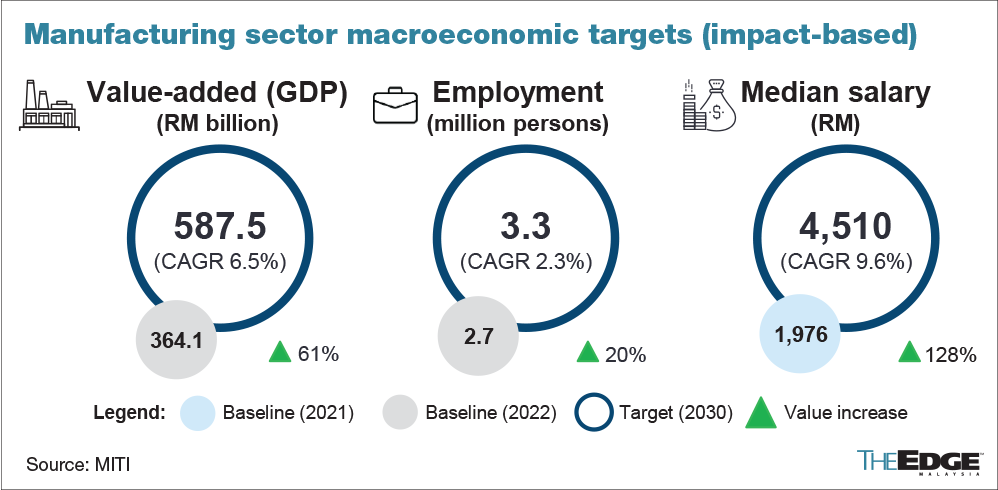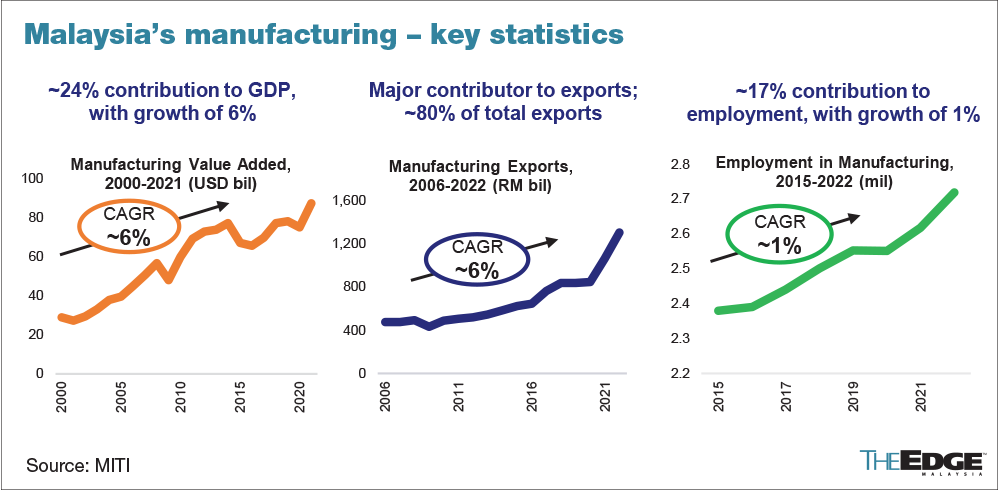NIMP 2030 to drive manufacturing GDP, offer clarity for investors — analysts
01 Sep 2023
The New Industrial Master Plan 2030 (NIMP 2030), while expected to boost the manufacturing gross domestic product (GDP) by 6.5% annually, contributing RM587.5 billion to total GDP by 2030, also provides a “much clearer signal” to investors on the future of the country and its key matters.
Khazanah Research Institute deputy director Yin Shao Loong said the NIMP 2030 is timely to implement amid the current geopolitical movements, mainly in the semiconductor sector, as well as other impactful sectors.
“Now [investors] can see (clearer, the future of the country and its key matters), based on the plans and the framework, as well as in terms of the high level on what [the country] is going to achieve. So I think it (the NIMP 2030) will have a positive [response] from the investors,” he noted.
Meanwhile, MIDF Research said the announcement of NIMP 2030 is not expected to spur significant buying or selling reactions in the equity market in the short term.
“We expect [that] the immediate market undertone shall continue to be dominated by a monetary statement or action of the US Fed (Federal Reserve). Hence, we maintain our FBM KLCI end-2023 target at 1,540 points or PER23 (price-earnings ratio for 2023) of 15.3 times,” it said.
With the NIMP 2030 as a catalyst, manufacturing is expected to record a compound annual growth rate (CAGR) of 6.5% between 2022 to 2030 — higher than the CAGR of 4.8% in 2015 to 2019.

This totalled a 61% increase from 2022, as growth accelerates in high-impact emerging growth sectors, including chemical, electrical and electronics (E&E), electric vehicle (EV), aerospace, pharmaceutical and advanced materials.
“As of 2022, the combined GDP of these sub-sectors made up more than half of the manufacturing GDP, with great potential to house many additional high-tech and high value-added industries,” MIDF said in a note on Friday.
The NIMP 2030 is set to drive employment up by 2.3% annually on average between 2022 until 2030, which will create a total of 3.3 million new jobs or a 20% increase in employment by 2030.

The additional employment will primarily be in high-skilled jobs, as the NIMP will promote greater adoption of automation that will reduce reliance on low-skilled labour.
This will push median pay to rise on a cumulative average of +9.6% between 2021-2030 to reach RM4,510 by 2030, or +128.0% increase from 2021.
This will also be supported by the government’s progressive wage system (PWS) to increase the number of skilled workers and accelerate wage growth.
NIMP targets comprehensive growth of highly-valued growth sectors
Compared to the previous Industrial Master Plan 3.0 (IMP 3.0), which only focused on several sectors under the manufacturing industry, “the biggest shift right now is that we are focusing on missions, rather than trying to achieve sectoral targets. When you [set to] achieve a sectorial target, it doesn’t always deliver strong results,” Yin told reporters after the NIMP 2030 launch on Friday.
Earlier, Prime Minister Datuk Seri Anwar Ibrahim unveiled the NIMP 2023, which will focus on high-impact sectors, namely E&E, chemical, EV, aerospace, pharmaceutical and advanced materials.
“So, it is important for Malaysia to have a strategy going forward, in terms of delivering the best kind of future for the country.
“This seven-year plan — until 2030 — is important because we need to do these big structural shifts, and it’s not gonna happen overnight,” he said.
Execution is key
While NIMP 2030 has outlined the mission-based approach to drive high-impact industrial sectors, Socio-Economic Research Centre (SERC) executive director Lee Heng Guie said the real challenge now is the execution of the plans.
“Without a careful and planned approach to execution, strategic goals cannot be attained. Hence, we need a pragmatic approach to monitor and track the progress of the proposed action plans and mission-based projects,” Lee told reporters.
He said the plans also need timely interventions and facilitation across collaborations between ministries and agencies, as well as provide resolutions to achieve the deliverables.
“While the lead agencies and involved parties were identified to implement the mission-based projects, accountability and responsibility are therefore critical to ensuring a successful implementation of the mission-based projects.
“We need strong accountability to ensure alignment and coordination among the stakeholders and parties, to clearly define the project scope and deliverables,” he said.
Meanwhile, Lee welcomed the government’s move to launch the NIMP 2030, as he sees the new plan as an effective one-stop centre to facilitate investments into the country.
“This is a crucial mechanism, whereby relevant ministries and government agencies are coordinated at a single point to provide prompt, efficient and transparent services to investors, to shorten and simplify administrative procedures and guidelines ultimately, thereby removing bottlenecks faced by both local and foreign investors in establishing and running businesses in Malaysia,” he said.
Source: The Edge Malaysia


